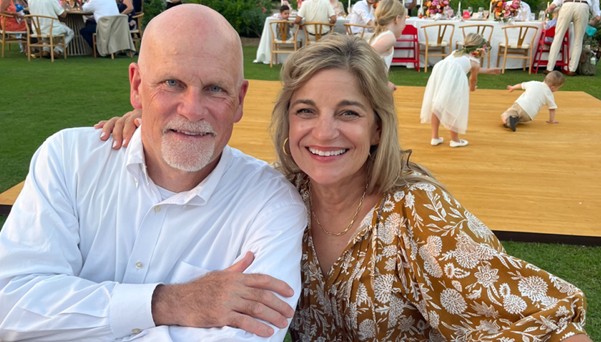
When it comes to charitable giving techniques, Donor Advised Funds (DAF) are often overlooked and underutilized. Not so for Pete and Cindy Burton of Stilwell, KS. Having been intentional and discipled about giving proportionally throughout their adult life, the DAF provides the Burtons with an easy way to organize and make charitable gifts.
“It just makes our giving so much easier,” says Pete. “Our gifts come out of a single bucket.”
The Kansas Methodist Foundation has a close relationship with Stilwell United Methodist Church. Stewardship presentations and generosity workshops provided opportunities for the Burtons to meet KMF staff and learn about our programs.
According to Pete and Cindy, “We know people who use other foundations and organizations to manage their donor advised funds, but we wanted to partner with an entity that shared our values and were more aligned with our charitable goals, so we chose to partner with the KMF."
In 2018, the Burtons established a Donor Advised Fund at the KMF. Since then, Pete and Cindy have made several gifts to their donor advised fund at opportune times and then direct KMF to make gifts to their chosen charities on their behalf.
But why do they do that?
In 2018, the standard deduction for tax purposes doubled from the previous amount and has been adjusted for inflation ever since. For 2024, the standard deduction is $14,600 for an individual or $29,200 for a couple. What does that mean? Prior to 2018, many people and families itemized deductions since those amounts typically added up to a total higher than the then standard deduction. Mortgage interest, educational loan interest, child tax credits, medical expenses, and charitable gifts commonly resulted in deductions that would lower tax liability and exceeded the then allowable standard deduction.
Since 2018, though, individuals and families typically no longer have itemized amounts totaling more than the standard deduction. In 2020, over 87% of tax filers used the standard deduction. While a higher standard deduction makes it easier for tax preparers, people who make charitable gifts may no longer “feel” the benefit of their charitable gifts when it comes tax time.
Enter in Donor Advised Funds. The standard deduction increase ushered in a new giving opportunity, and DAFs are a significant part of that strategy. If people have the ability to do so, then they can leverage a giving technique known as “bunching.” By transferring a more significant dollar amount to a DAF in a single tax year, the donor may be able to itemize in Year A but use the amount stored in the DAF for charitable gifts in subsequent years.
DAFs function like a charitable savings account. Gifts are made and credited for tax purposes at the time the donor makes the contribution to a DAF. Afterwards, the donor can use those funds at any time to make gifts to charities of their choice. Funds can be given, used, and then replenished at opportune times to continue the cycle.
“Once we went through one annual cycle with our DAF, we were sold on its value. It makes our giving so much more efficient,” says Pete.
The chart below highlights how an individual who wants to make four years’ worth of gifts in a single year would use this technique.
| 2024 | 2025 | 2026 | 2027 | |
| DAF Contribution | $ 45,000 | $ 0 | $ 0 | $ 0 |
| Your Annual Gifts to Charities | $ 13,000 | |||
| Your Annual Gifts to Charities from Your DAF | $ 14,000 | $ 15,000 | $ 16,000 | |
| *Annual Tax Deduction | $ 58,000 | Stan Deduct | Stan Deduct | Stan Deduct |
*Note: Tax deductible charitable gifts are capped at 60% of Adjusted Gross Income (AGI), and unused deductions can be rolled over to other tax years for up to five years. KMF recommends working with your tax professional to analyze your tax situation and ensure DAF’s are right for you.
Most people are not sitting on enough cash to make this technique helpful; however, consider these scenarios:
According to Pete and Cindy, their DAF has been a useful giving tool. “The beauty of it is that the donor advised fund takes the question of taxes off the table. We already have our tax receipt and tax deduction. Now we can just give generously to charities and causes we want to support without having to think about any tax-related issues.”
If you would like to visit about DAFs or other tax-advantaged giving strategies, then we are here to assist. Please contact Tyler Curtis at tyler@kansasmethodistfoundation.org or at 620.664.9623 for more information.